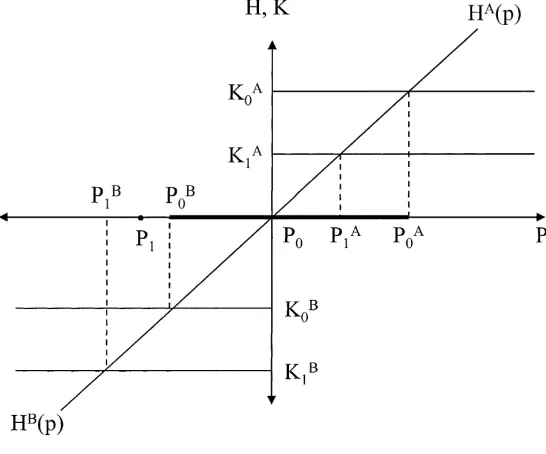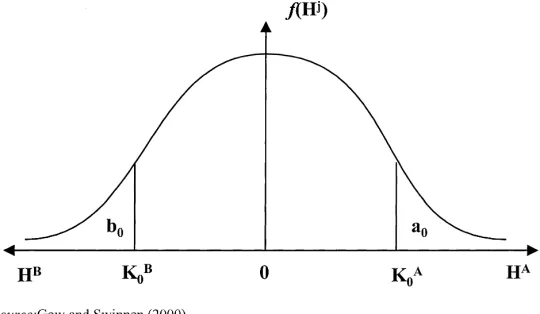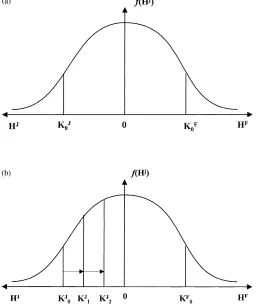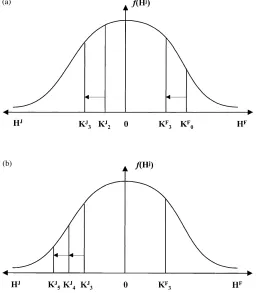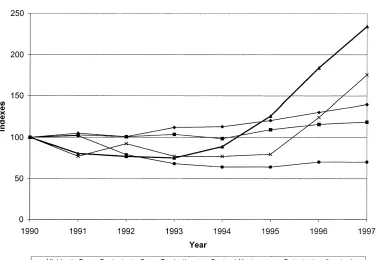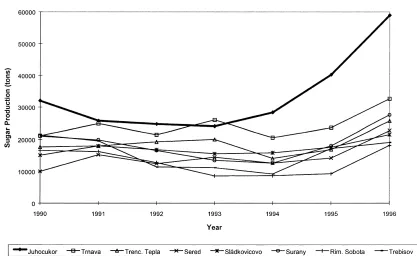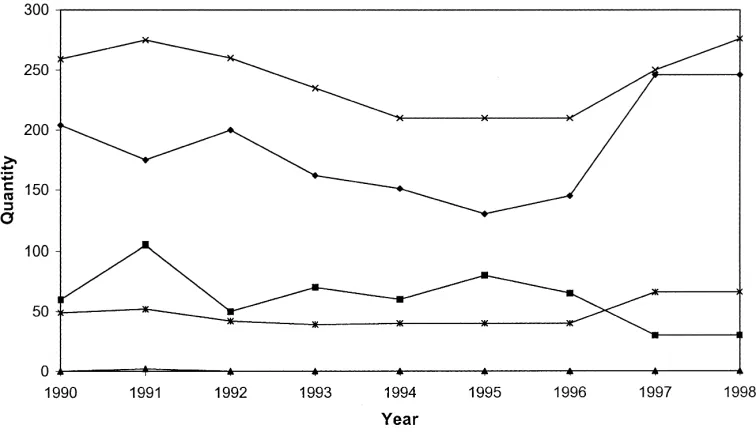How private contract enforcement mechanisms can succeed where
public institutions fail: the case of Juhocukor a.s.
Hamish R. Gow
a,b,∗, Deborah H. Streeter
c, Johan F.M. Swinnen
daPolicy Research Group, Katholieke Universiteit Leuven, Louvain, Belgium
bDepartment of Agricultural and Consumer Economics, University of Illinois at Urbana-Champaign,
326 Mumford Hall, 1301 W. Gregory Dr., Urbana, IL 61801, USA
cDepartment of Agricultural, Resource and Managerial Economics, Cornell University, Ithaca, NY 14853-7801, USA dEuropean Commission and Policy Research Group, Katholieke Universiteit Leuven, Louvain, Belgium
Abstract
The enforcement of contracts is necessary for efficient exchange and investment in economic activities. Contracts can be en-forced through a variety of mechanisms, both public and private. However, in many developing and transitional countries these public institutions are either absent or ineffective in ensuring contract enforcement. Under such conditions, private enforcement mechanisms may provide a suitable replacement for public enforcement institutions. This may be done externally through a third party or internally through self-enforcing agreements. This paper analyzes the use of “self-enforcing” arrangements or “internal” private enforcement mechanisms. Using a case study of an agri-business in a transition economy — Juhocukor a.s., a Slovakian sugar processor — we show that the use of “internal” private contract enforcement mechanisms can have a sig-nificant positive effect on output and efficiency for both partners to the exchange transaction in an environment characterized by the absence or ineffectiveness of public enforcement institutions. © 2000 Elsevier Science B.V. All rights reserved.
Keywords:Contract enforcement; Hold-ups; Sugar; Transition agriculture
1. Introduction
The enforcement of contracts, both formal and informal, is an important pre-condition for efficient exchange and investments in economic activities in general and agri-food business in specific. Contracts can be enforced through a variety of mechanisms. Public institutions, such as official courts, can ensure legal enforcement of contracts.
There are many situations where public institutions are either absent or ineffective in ensuring contract en-forcement. This is, for example, the case in developing
∗Corresponding author. Tel.:+1-217-265-0320; fax:+1-217-333-5538.
E-mail address:[email protected] (H.R. Gow).
countries with weak public institutions, or in coun-tries in transition where the enforcement institutions themselves are being reformed or created.
Under such conditions private mechanisms may replace public institutions to enforce contracts. Such private contract enforcement may be done by third parties, i.e. external enforcement. A specific exam-ple of this could be the hiring of Mafia-type private enforcement agents. While such mechanisms may be effective in enforcing contracts, they may have unwanted externalities.
This paper analyzes the use of “internal” private contract enforcement mechanisms, i.e. contractual ar-rangements between both parties in an exchange that makes the contract “self-enforcing”. We show that such (internal) private contract enforcement
anisms can have significant effects on output and efficiency for both partners in the exchange with a case study of an agri-business in a transition country: Juhocukor a.s., the largest sugar processing company in Slovakia.
Slovakian reforms that started in 1989 caused a col-lapse of contract enforcement mechanisms resulting in hold-ups and contributed to declines in output and investment. The introduction of contract innovations in 1993 under new management induced contract self-enforcement with its sugar beet suppliers. The results of this private mechanism of contract enforce-ment were dramatic: between 1993 and 1997 output increased by over 200% and beet deliveries by more than 150%, with yields increasing strongly both at the processing and at the farm level.
We use a new institutional economics model to explain how the introduction of several company pro-grams made the contracts self-enforcing and how this was a critical factor contributing to huge increases in output and productivity. We discuss spillover ef-fects of the company’s contract innovation, as well as other hypotheses for the observed effects. Further, we discuss why the company has chosen the specific contract form out of a range of institutional options.
2. A model of private contract enforcement
2.1. Contracts and enforcement
Contracts are naturally incomplete as agents find it difficult and expensive to foresee all possible con-tingencies and to enforce these contracts, especially when outcomes are unobservable or non-verifiable by a third party (Hart, 1995). Contractual incompleteness often results in parties exposing themselves to ex post costs and hazards related to their sunk investments in relationship-specific assets, that is the occurrence of hold-ups.
Mechanisms to reduce the likelihood of a hold-up include private sanctions and legal (court) enforce-ment. Private sanctions include both the losses that result from termination or non-renewal of the contract or relationship1 and the damage to the reputation of
1Formally, the losses resulting from termination or non-renewal
of the contract or relationship equal the present value of the future quasi-rents that accrue to the non-salvageable relationship-specific investments.
the party holding-up the transaction. The latter cludes future transacting parties imposing an in-creased cost of doing business on the reneging party by demanding more explicit and/or favorable contrac-tual terms and preferring written contracts to verbal promises.
Traditional contract theory usually considers court enforcement and private enforcement as alternatives. However, Klein (1996) emphasizes a fundamental complementarity between public and private enforce-ment. Contractual terms are used “to economize on the amount of private enforcement capital necessary to make a contractual relationship self-enforcing by merely ‘getting close’ to the desired performance in a wide variety of circumstances (without creating undue rigidity) and to let the threat of private enforcement move performance the remainder of the way to the desired level” (pp. 455 and 456).
It is sometimes not viable to use legal dispute mechanisms due to a combination of litigation costs, ineffective contract law, poor third party verifiability, and the potential loss of the only suitable trading partner. This is especially true in transition economies where many sectors are characterized by (geograph-ical) monopolies or monopsonies. Therefore, the potential loss of their sole trading partner can im-pose high costs upon an enterprise, especially when the relationship-specific investment has already been sunk. Further, in many transition countries the legal and judicial systems are in their embryonic stages of development, hence court decisions are highly uncertain and non-transparent.
Firms may also prefer incomplete contracts. Strict contractual terms may produce unwanted rigidity. For example, once contractual terms are set, one of the parties may hold-up the transaction by enforcing the literal terms even if these run against the initial intentions of the contract. With incomplete contracts parties have greater flexibility if future market condi-tions deviate substantially from expectacondi-tions.2 Thus transacting parties may intentionally elect to leave specifications out of the contract, opting instead to
2 This is one of the likely reasons for the popularity of spot
use private sanctions to enforce the contractual terms as opposed to courts (Klein et al., 1978, 1996).
2.2. Hold-ups and self-enforcing contracts
At each point in time, both partners in a contract weigh the costs and benefits of holding-up the contract. A hold-up will occur when the benefits are greater than the costs to one party. Transacting parties will only engage in a transaction if they expect that both parties will honor the (implicit) contract, that is if for both parties the expected costs of breaking the contract are larger than the expected benefits.
Hold-ups occur whenunanticipatedchanges in the external environment affect the cost/benefit ratio suf-ficiently to make contractual breach optimal for one party. To illustrate this, consider the following ex-ample from Gow and Swinnen (2000). Company A, producer of product x, needs to invest in production facilities specific for a certain delivery to company B which processes product xinto producty. To pre-vent a hold-up by company B after company A makes the investment, both parties agree on a contract which specifies product characteristics (“quality”), quantity
Fig. 1. The self-enforcing range in contracts.
may alter the value of specific investments, and therefore, the benefits of a hold-up, yet as long as the relationship remains within the self-enforcing range where each transacting company’s benefits of a hold-up are less than the costs, a hold-up will not occur.
In this framework, hold-ups only occur when a suffi-ciently large unanticipated event shifts the underlying market conditions outside of the self-enforcing range. A hold-up thus would never occur in a fully anticipated world. If the transacting company had anticipated the present market conditions, either it would not have undertaken the initial investment or it would have in-sisted upon different specifications in the contract.
To make the contract self-enforcing under the new conditions, a rearrangement of the private enforcement capital is required. This can be done either by enlarg-ing the self-enforcenlarg-ing range through increasenlarg-ing the en-forcement capital of one partner (or both partners), or by redistribution of the present enforcement capital be-tween the partners. To illustrate this, assume that after the contract has been agreed the market price declines top1< p0B(see Fig. 1). Company B will breach the contract and, if A realizes this, A will refuse to make any investment for delivery to B. To make the contract self-enforcing and to induce A to invest and to supply its product to B, B can either increase its investment specific to the contract with A, for example fromK0Bto K1B, making it more costly for itself when the contract is not honored. As a consequence, the price p1 falls
Fig. 2. The probability of contract self-enforcement.
within the new self-enforcing contract rangepB1–p1A. Instead of increasing its own investments, B can also finance some of A’s relationship-specific investments, thereby shifting the costs of the contract breach from (K0A, K0B) to (K1A, K1B). In doing so, againp1falls in the new self-enforcing contract rangepB1–p1Aand the contract will be honored.
If agents have full information on the market price
p, hold-ups would never occur. However, ex ante, both agents usually only have expectations on the market price (see Fig. 2). We definef(Hj) as the expected prob-ability distribution of the hold-up benefits of company j,Hj(with j=A, B), which results from an underlying expected probability distribution of pricep, with Hj
(p)=0 for p=p0, i.e., the benefits of the hold-up are zero when the actual pricepis the expected pricep0. The probability of either A or B holding-up the con-tract with initial breaching costs (K0A, K0B) are areas
a0andb0, respectively. Hence the expected probabil-ity that the contract will be honored is 1−a0−b0.
3. A case study of contract enforcement during transition: Juhocukor a.s.
315 000 t of sugar beets were delivered to the company in 1990.
Data for the case study were collected over a period of 2 years (1997–1998) through an extensive series of in-depth interviews with management and contracting specialists from Juhocukor, management of contract-ing farms, management of competcontract-ing processors, and experts from various institutions, including the Slovak Republic Ministry of Agriculture, the Research Insti-tute of Economics of Agriculture and Food Industry Bratislava (VUEPP), the Slovak Sugar Beet Producers Union, the Slovak Sugar Processors Association and the Slovak University of Agriculture in Nitra. These primary data were supplemented with secondary data collected from a range of sources including the Min-istry of Agriculture and VUEPP among others. Beside the quantitative information reported in this paper, the data collected included qualitative information on pro-cessing firm and farmer resource allocation, contract-ing, investment, and pricing decisions in response to market conditions.
3.1. Economic reforms cause contract hold-ups
Before 1989, sugar production and processing in Slovakia were centrally planned and vertically in-tegrated through the central command system. The central authority provided contract enforcement and transacting parties faced a low (or zero) probability of being held-up.
The reforms from 1989 onwards caused several institutional changes, leading to a breach of supplier contracts by Juhocukor. First, economic reforms split the vertically integrated chains into autonomous en-terprises. Previously both the up- and down-stream industries were composed of large state-owned firms, usually one per sector and in certain cases operating on both sides of the market, such as was the case with the PZN — the Agricultural Supplies and Procurement Organization. This allowed production and resource allocation decisions as well as production and target prices to be centrally planned and set. However, be-ginning in 1991 the then Czechoslovakian (and later Slovak) government started restructuring the agri-food processing sector, which had previously been com-prised of 30 firms with 188 processing plants, into 197 autonomous state-owned enterprises. These firms were later privatized either through the first voucher
privatization program or sold to selected so-called “strategic purchasers” in the second stage (OECD, 1997). Within the sugar sector, the initial restructur-ing resulted in the establishment of eight independent sugar-processing plants with daily slicing capacities ranging from 1110 to 4800 t of beets per day.
With respect to farm restructuring, land reform and privatization also began in the early 1990s. Most land was restituted to former owners, resulting in a highly fragmented land ownership structure (Swin-nen, 1999). However, this did not cause fragmentation of the farms as land restitution to small, mostly ab-sentee, landowners gave an advantage to large farms in land contracting. In combination with government regulations complicating the withdrawal of assets from farming cooperatives and companies, this has resulted in the lowest level of individual farming in all of Eastern Europe (Mathijs and Swinnen, 1998). Hence, large-scale farming continues to be the dom-inant form of agricultural production in Slovakia, including for sugar beet production.
Second, the previous legal system or the central planning authority was no longer able to enforce the contractual terms and a new legal enforcement mech-anism was absent or ineffective.3
Third, since the transacting parties had no previous experience with hold-ups, private enforcement levels were left unchanged and producers continued making relationship-specific investments. This situation is de-picted in Fig. 3a where the symbols can be interpreted similar to Fig. 2 with J representing Juhocukor and F a farm supplying sugar beets to Juhocukor.
Fourth, macro-economic reforms and price and trade liberalization caused dramatic changes in both nominal and relative prices. After many years of near price stability, average inflation jumped to over 60% in 1991 while the terms of trade declined by over 40% in the sugar sector during the beginning of the 1990s. It is not difficult to imagine that following these re-form and price shocks market conditions moved H outside the self-enforcing rangeK0J–K0F.
3 Many Eastern European governments have since drafted
Fig. 3. Impact of economic transition on the probability of contract hold-up between Juhocukor (J) and sugar beet farms (F): (a) probability of contract hold-up following removal of central state contract enforcement and price liberalization; (b) impact of Juhocukor financial distress (1) and repeated hold-ups (2).
The result was a hold-up of the contracts by Juhocukor under the form of long (up to several months) delays in payments to farms for delivered sugar beets. The payment delays effectively provided Juhocukor with an interest-free loan from supplying farms for the length of the delay. Under the high in-flation conditions of Slovakia in the early 1990s the implicit rent extraction was significant. While precise data on Juhocukor payment delays are unavailable, for the Slovak Republic as a whole, the average pay-ment delays by food processors to farms supplying raw materials was around 100 days in 1994 and 1995.
The probability of contract hold-ups by Juhocukor was reinforced by two factors. First, the combination of macro-economic reforms, the simultaneous
institu-tional reform of the banking system, both raising the cost of capital, and the cut in government subsidies caused severe financial distress for Juhocukor, thereby effectively reducing its capital costs of breaching the contract. This is illustrated in Fig. 3b with a decline fromK0JtoK1J, thereby increasing the likelihood of a hold-up.
Once Juhocukor started holding-up farms by late payments, this further reinforced the probability of hold-ups in the future as it undermined the reputation of Juhocukor, thereby reducingK1J toK2J, and further causing the self-enforcing range to shrink further.
cash flow and profitability problems.4 As a conse-quence, farmers no longer wanted to invest in sugar beet production for Juhocukor: sugar beet deliveries to Juhocukor declined from 315 000 t in 1990 to 214 000 t by 1993, contracted hectares from 7800 to 6000 ha, and its sugar production from 32 000 to 24 000 t over the same period (see Fig. 5). While an important part of the decline in output is likely due to a decline in terms of trade for sugar beet production over the same period (output over input prices declined by around 35% between 1989 and 1993), an important share is likely due to the contract disruptions — as reflected in the decline in contracted hectares (see further for a more extensive discussion).
In the framework of our contract model, the reform induced changes in the institutional and market con-ditions and the consequent reduction of Juhocukor’s enforcement capital shifted the expected market con-ditions outside the self-enforcing range, reducing in-centives for beet suppliers to finance contract-specific investments.
3.2. Company take-over and contract innovations
In 1993, Eastern Sugar BV, a 50:50 joint venture between Tate and Lyle and Saint Louis Sucre, created for their sugar activities in the CEECs, purchased a majority shareholding of Juhocukor a.s. To stimulate farms to invest in high quality beet production and deliver it to the company after the take-over, Juhocukor introduced several contractual innovations along with a range of accompanying input facilitation programs intended to make the contracts self-enforcing. These innovations reduced the likelihood of a hold-up, as perceived by the beet producers, by restructuring the costs and benefits of a contract hold-up. In addition, they facilitated farmers’ access to inputs.
First, Juhocukor introduced an input provision and investment facilitation program for farms that signed long-term sugar beet delivery contracts with the com-pany. The contracts specified a fixed base price, to
4To illustrate this, data from 1994 and 1995 show that the length
of payment delays was strongly negatively correlated with the profitability of Slovak farms. In 1994, the average number of days of delays for collection of accounts receivables was 81 and 111 for profitable and unprofitable farm, respectively, in 1995, average delays were 82 and 113 days for profitable and unprofitable farm, respectively (OECD, 1997).
be paid on time by Juhocukor, at a price slightly higher than the prevailing market prices. They in-cluded bonuses and penalties for quality, based on sugar content, as well as a pre-set tonnage and planted area.
The input provision facilitation program assisted farmers in the purchasing of inputs, such as seeds, fertilizer, chemicals, etc, specifically for the produc-tion of sugar beets. The program allowed for a set amount of inputs per hectare to be purchased, based upon technical standards, from a select group of spec-ified suppliers with whom Juhocukor had negotiated price reductions and guaranteed the repayment of the purchases.
Investment and financial facilitation was initially provided on an ad hoc basis. In 1995, Juhocukor devel-oped a formalized program with Polnobanka (the main bank lending to agriculture in Slovakia) for the financ-ing of machinery investment and workfinanc-ing capital. The program provided Polnobanka with a guarantee for the repayment of the loan and provided the contract grow-ers with an interest rate subsidy between 3 and 7%.
Through accepting the residual claim on these investments via guarantees with the companies pro-viding inputs and credit to the farms, Juhocukor ef-fectively increased its own costs of contractual breach (fromK2J toK3J in Fig. 4a), thereby making its hon-oring of the contract more likely, and its promises to do so more credible.
At the same time the program reduced the costs of a Juhocukor hold-up for producers. In the event of non-payment, beet producers would not have to pay for their purchased inputs and would only lose returns to their labor and personal capital contributions. (More generally, Juhocukor, through this program, reduced the costs for farms of any contract breach, including that of the farms themselves fromK0FtoK3Fin Fig. 4a.) Hence, by simultaneously reducing the likelihood of a hold-up by Juhocukor and limiting the costs of it for producers, the programs induced farms to in-vest in sugar beets. In other words, by reallocating the private enforcement capital from the suppliers to it-self, Juhocukor shifted the self-enforcing range from K2J–K0F to K3J–K3F making it less likely that market conditions would induce a Juhocukor hold-up.
Fig. 4. Impact of contract innovations and support programs following Juhocukor (J) take-over: (a) impact of input and investment facilitation program (3); (b) impact of technical support (4) and restored reputation (5).
and managerial advice, etc. These programs increased the level of relationship-specific investment that Juhocukor had committed to each farmer’s human capital. This in turn increased the amount of private enforcement capital Juhocukor had committed to its relationships with the sugar beet farmers from K3J to K4J and enlarged the self-enforcing range of the contract to K4J–K3F (Fig. 4b). Additionally, the tech-nical support and extension programs also allowed Juhocukor to monitor the farms.
Third, to restore its damaged reputation, the com-pany combined a strategy of paying farms on time (it would be the only sugar company providing timely payments in Slovakia) with a media and public re-lations campaign. The campaign informed potential producers about the contracts and programs and sig-naled to producers that Juhocukor was willing to pub-licly risk its reputation to back these contracts. As its reputation increased over time so did the amount of
private enforcement capital that Juhocukor had com-mitted to the contracts fromK4J toK5J, further enlarg-ing the self-enforcenlarg-ing range.
3.3. Impact
Fig. 5. Changes in production and productivity of Juhocukor a.s. and the sugar beet farms (1990–1997).
At the same time yields on the farms increased from 32.5 t/ha with 14% sugar content in 1992 to 45 t/ha with 16.5% sugar for the 1997 campaign. As a re-sult, Juhocukor’s daily slicing capacity increased from 3719 t/day in 1993 to 5200 t/day for 1997. Sugar pro-duction more than tripled: from 24 700 to 75 000 t in 1997.
3.4. Contract enforcement versus price changes
As argued above, it is difficult to assess the pre-cise contribution of the contracting problems to the fall in output of sugar beets and processed sugar be-tween 1989 and 1993 as relative prices also changed strongly over the same period. For example, Macours and Swinnen (2000) estimate that, on average for crop production in eight CEECs over the period 1989–1995, around half the output decline is due to price effects. However, over the 1993–1997 period when the dramatic increases in output, contracting, and produc-tivity occurred, the ratio of output over input prices
for sugar beet farms was stable (see Fig. 5). Since both the relative prices and the payment system were con-stant over the 1993–1997 period, it seems reasonable to conclude that prices had little significant impact on output and productivity, and that the productivity effects are to a large extent due to the contract innova-tions and associated programs initiated by Juhocukor. Juhocukor offered an implicit premium above the market price in its contracts, as it paid at the time of delivery compared to most other companies where payments were structured over a period of time after delivery. However, these (implicit) price premia are endogenous to the contracting problem.5
This conclusion can be further supported by paring Juhocukor with other Slovakian sugar com-panies where output continued to fall or stabilized over the 1993–1995 period (Fig. 6). Only after these companies’ implemented similar contracts as
5 Greif (1997) explains why a premium above the market price
Fig. 6. Sugar production by processing company in Slovakia (1990–1996).
Juhocukor did output and productivity increase in these companies as well.
Furthermore, comparing the output developments with the contracted hectares suggests that initially (1993–1995) the contract innovations primarily in-duced an increase in beet yields (both tons per hectare and sugar content) of the farms that traditionally sup-plied Juhocukor. However, from 1995 onwards this changed dramatically. After 1995 — when 2 years of timely payments had improved Juhocukor’s reputa-tion and when the investment and financial facilitareputa-tion package for machinery investment and working capi-tal had become a formal program with Polnobanka — the contracted hectares increased more than doubled in 2 years, with little changes in either market prices or prices offered in the Juhocukor contracts (see Fig. 5).
3.5. Contractual convergence
The success of Juhocukor and its contracts induced imitation of these contractual arrangements by
com-peting firms, with a 1- or 2-year delay. Eggertsson (1990, pp. 53–55) refers to such development as competition among contractual arrangements: once a contractual innovation is seen to be successful, competitors will imitate it. Firms competing for the same farm factor resources (e.g. land) are forced to offer similar contractual arrangements, thereby causing contractual convergence. This is what has occurred in the Slovakian sugar beet market where the “Juhocukor-contract” has now become the stan-dardized contract offered to farmers by all sugar processors across the sector and sanctioned by the processors association.
Fig. 7. Sugar production, consumption, and trade in Slovakia.
recorded) consumption from 210 000 to 275 000 t. This combination resulted in downward price pressure in the processed sugar market.
Similar developments occurred in neighboring countries. In combination with the general decline in world market prices, the financial crisis in Russia that reduced export opportunities, and subsidized ex-ports from the EU, a price war has developed across the region since 1997. This has resulted in increased government protection of sugar producers in Central Europe. In Slovakia, the sugar PSE increased from 30% in 1995 to around 90% in 1999 (Swinnen et al., 2000).
3.6. More contractual spillovers
The contractual convergence and subsequent invest-ment and technology adoption at the upstream produc-tion level has not been confined solely to the directly affected commodity sector. Also adjacent commodity sectors adopted similar contracts, as these firms have also had to compete for the same factor inputs (e.g. land).
Another interesting spillover effect is that Polno-banka (the main agricultural bank) has now developed
a standardized series of credit lines that enable down-stream enterprises to provide farmers with advance payments for contracted supplies. The schemes use draft loans with the future harvest acting as the col-lateral and operate in a similar way to the previously discussed scheme.
4. Discussion
either. Having previously been held-up by Juhocukor, financially distressed farmers recognized that similar forward contracting within a costly enforcement en-vironment offered little to no additional protection than spot markets. Hence their investment incen-tives remain unchanged from those in spot markets. This leaves the previously discussed option which Juhocukor and others have adopted as the most ef-fective organizational structure to support efficient exchange and investment, and a stable supply of high quality inputs for their processing operations (Gow and Swinnen, 1998).
The second issue requiring further elaboration con-cerns the limitations of the model. First, the model implicitly assumes a level of asset specificity in sugar beet production. This assumption seems fair given the levels of location specificity due to the high cost of transporting raw beets, the physical asset speci-ficity related to sugar beet harvesters which cannot be used for other purposes, and especially the tem-poral specificity of beet with respect to storage and processing.
Second, the model does not explicitly deal with either ex post renegotiations or dynamics, as a dy-namic bargaining model might allow. If the problem were reformulated within a bargaining framework, the argument would follow something like this. For Juhocukor to get producers to make the required relationship-specific investment, Juhocukor would have to ex ante constrain its own ex post possi-bilities and ex ante signal these constraints to pro-ducers so that they would recognize that it would be too costly for Juhocukor to hold them up, ex post, after they have sunk their investments. Effec-tively, that is equivalent to what we argue Juhocukor has done in transferring private enforcement capi-tal between the parties. By accepting the residual cost on the producers’ investments through the in-put and financial facilitation programs and techni-cal support programs, Juhocukor has constrained its ex post possibilities and ex ante signaled this to producers.
Third, our model does not discuss different forms of collective action and social embeddedness that could be used to support exchange transactions. Implicitly, however, the reputation portion of the private enforce-ment capital captures part of these enforceenforce-ment forms (see Gow, 2000).
These, and some other areas, require further re-search. For example, our analysis should be expanded to include a wider range of firms and sectors from across the region in to understand the robustness of our findings. Is it necessary to have foreign invest-ment for the initial contractual innovation or can local firms provide the necessary contractual incentives? To what extent are the effects conditional upon the product characteristics? What impact does contrac-tual convergence in the procurement market have on product competition in the downstream sugar market and the capital structures of the competing proces-sors? Finally, how do different privatization programs affect the outcome?
5. Conclusions
Contract enforcement is necessary for efficient economic exchanges and investments. In the absence of public contract enforcement mechanisms, private enforcement mechanisms can work. This paper has shown that the use of “internal” private contract en-forcement mechanisms, i.e. contractual arrangements between two parties in an exchange, can make con-tracts “self-enforcing”.
The paper applied a new institutional economics model of contract enforcement to a case study of Juhocukor a.s., the largest sugar processing company in Slovakia. Economic reforms and the transition pro-cess caused a collapse of contract enforcement mech-anisms, which in turn caused Juhocukor to hold-up suppliers by delaying payments in a high inflationary environment. The result was a reduction in invest-ments by suppliers, a fall in contracted hectares with Juhocukor, and declines in output and efficiency.
improved incentives for sugar beet farms to make contract-specific investments. At the same time, by providing guarantees to banks and companies supply-ing inputs to the contracted farms the flow of inputs to these farms increased.
The results of the Juhocukor contract innovations and support programs were dramatic: between 1993 and 1997 contracted hectares with sugar beet farms more than doubled, output increased by over 200% and beet deliveries by more than 150%, with yields increasing strongly both at the processing and at the farm level. We showed that the critical factor was con-tract enforcement.
Empirical evidence further suggests that the intro-duction of the contractual arrangements has caused spillover effects to other firms and even to other sec-tors. Competing firms have imitated the contractual arrangements inducing positive impacts beyond the direct contract effects.
Acknowledgements
The authors gratefully acknowledge the financial support of the FAIR program of the EU Commis-sion (FAIR1-CT95-0029) and the Edward Heslop Fellowship and research assistance from the staff of Juhocukor, Slovak Republic Ministry of Agricul-ture, Slovak Sugar Processors Association, VUEPP. Additionally, special thanks go to Gejza Blaas, Neil Gow, Jason Hartell, Erik Mathijs, four anonymous reviewers, Christopher Barrett and Thomas Reardon, editors of this special issue, and seminar participants at Cornell, IAMO, Illinois, LICOS, Leuven, AAEA, EAAE, IAMA and ISNIE annual meetings for helpful comments. The authors are solely responsible for the views expressed within the paper and for any
remain-ing errors. The views expressed within this do not necessarily reflect those of the European Commission.
References
Eggertsson, T., 1990. Economic Behaviour and Institutions. Cambridge University Press, Cambridge, UK.
Gow, H.R., 2000. Essays on contract enforcement in transition agriculture. Ph.D. Dissertation. Cornell University, Ithaca, NY. Gow, H.R., Swinnen, J.F.M., 1998. Up- and down-stream restructuring, foreign direct investment, and hold-ups in agri-cultural transition. Eur. Rev. Agric. Econ. 25 (4), 331–350. Gow, H.R., Swinnen, J.F.M., 2000. Contract enforcement in
transition economies. Policy Research Group Working Paper. Katholieke Universiteit Leuven, Louvain, Belgium, p. 27. Greif, A., 1997. Contracting, enforcement, and efficiency:
economics beyond the law. In: Annual World Bank Confe-rence on Development Economics 1996. The World Bank, Washington, DC, pp. 239–265.
Hart, O., 1995. Firms, Contracts and Financial Structure. Clarendon Press, Oxford.
Klein, B., 1996. Why hold-ups occur: the self-enforcing range of contractual relationships. Econ. Inquiry 36, 444–463. Klein, B., Crawford, R.G., Alchian, A.A., 1978. Vertical
inte-gration, appropriable rents and competitive contracting process. J. Law Econ. 21 (2), 297–326.
Macours, K., Swinnen, J., 2000. Causes of output decline during transition: the case of central and eastern European agriculture. J. Comp. Econ. 7 (3), 637–664.
Mathijs, E., Swinnen, J.F.M., 1998. The economics of agricultural decollectivization in east Central Europe and the former Soviet Union. Econ. Dev. Cult. Change 46 (4), 1–26.
OECD, 1997. Review of agricultural polices: Slovak Republic. Centre for co-operation with economies in transition. Orga-nization for Economic Co-operation and Development, Paris. Swinnen, J.F.M., 1999. Political economy of land reform choices
